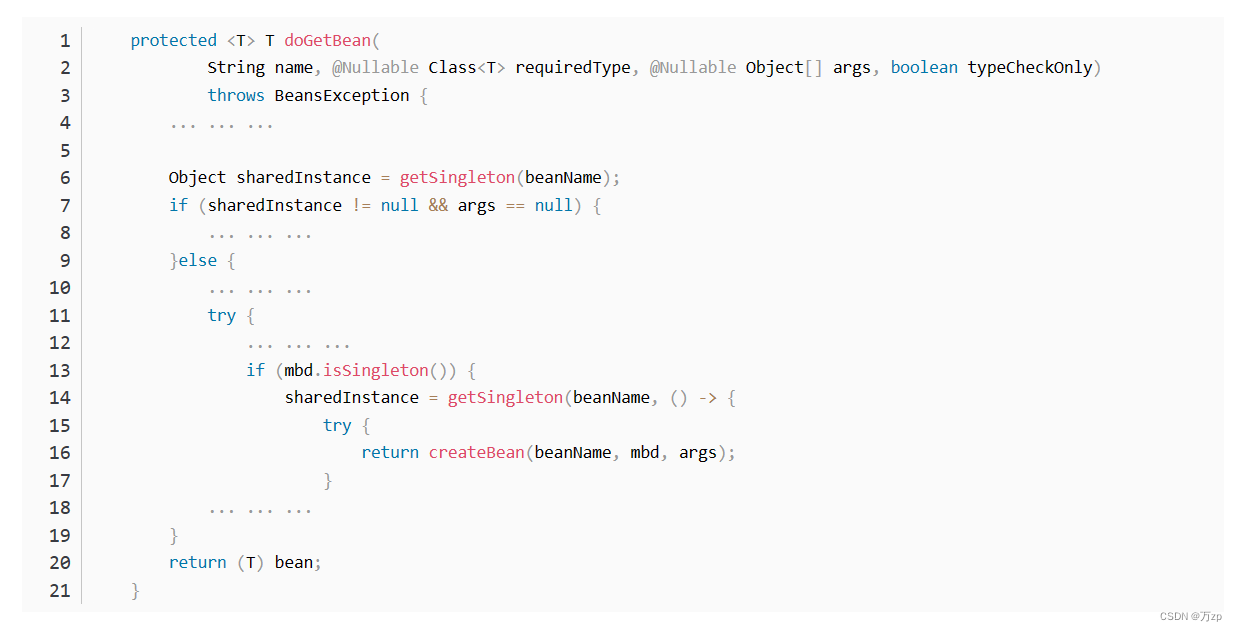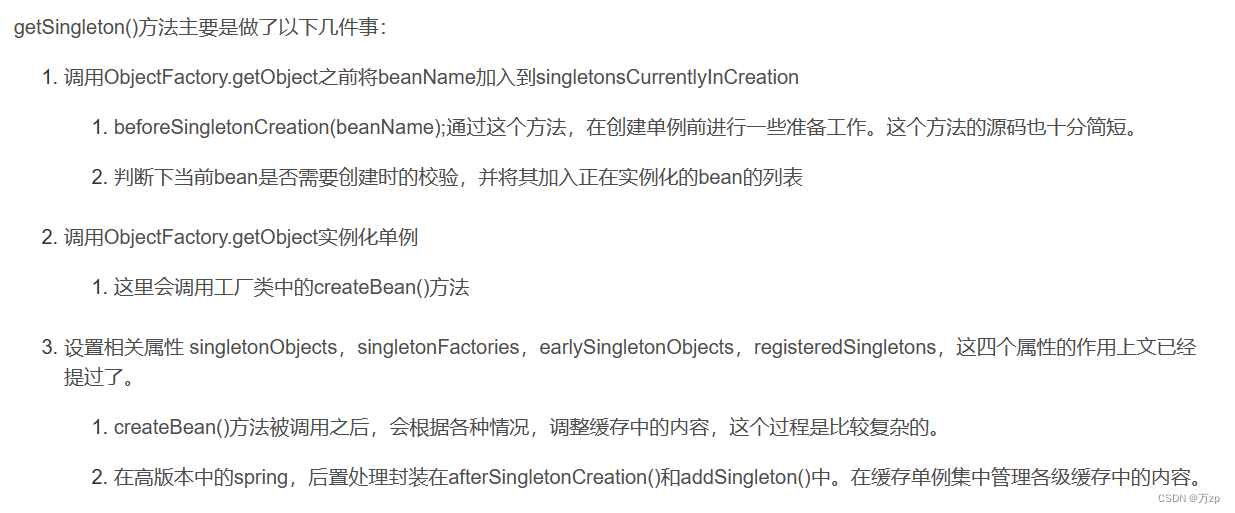1.举个例子:
所谓循环依赖,就是A中依赖了B,而B又依赖了A,如下:
@Service
public class BeanServiceA {
private String name = "serviceA";
@Autowired
BeanServiceB beanServiceB;
public void testMethod() {
System.out.println();
}
}
@Service
public class BeanServiceB {
private String name = "serviceA";
@Autowired
BeanServiceA beanServiceA;
}
本文举栗中A要进行代理,而B不需要
2.Bean创建过程及循环依赖解决:
先介绍一下循环依赖涉及的重点方法DefaultSingletonBeanRegistry#getSingleton(java.lang.String, boolean)
//返回在给定名称下注册的(原始)singleton对象。
//检查已经实例化的singleton,并允许早期对当前创建的单例的引用(解析循环引用)
@Nullable
protected Object getSingleton(String beanName, boolean allowEarlyReference) {
// 快速检查没有完整单例锁的现有实例,如果有就直接返回,如果没有,进入创建流程
// 先从一级缓存中获取
Object singletonObject = this.singletonObjects.get(beanName);
if (singletonObject == null && isSingletonCurrentlyInCreation(beanName)) {
// earlySingletonObjects:早期singleton对象的缓存:bean名称到bean实例。
// 从二级缓存中获取早期的bean实例
singletonObject = this.earlySingletonObjects.get(beanName);
if (singletonObject == null && allowEarlyReference) {
synchronized (this.singletonObjects) {
// 在完整的单例锁中一致地创建早期引用
// this.singletonObjects:singleton对象的缓存:bean名称到bean实例
singletonObject = this.singletonObjects.get(beanName);
if (singletonObject == null) {
// 这里为什么要再次从earlySingletonObjects中获取一次?
singletonObject = this.earlySingletonObjects.get(beanName);
if (singletonObject == null) {
// 从各级缓存中都没有获取到singletonObject,进入创建流程
// 从三级缓存中获取工厂对象
ObjectFactory<?> singletonFactory = this.singletonFactories.get(beanName);
if (singletonFactory != null) {
singletonObject = singletonFactory.getObject();
// 存入二级缓存
this.earlySingletonObjects.put(beanName, singletonObject);
// 从三级缓存中删除
this.singletonFactories.remove(beanName);
}
}
}
}
}
}
return singletonObject;
}
public boolean isSingletonCurrentlyInCreation(String beanName) {
return this.singletonsCurrentlyInCreation.contains(beanName);
}
2.1 BeanServiceA的创建:
在创建bean时,会调用doGetBean方法,首先通过getSingleton方法从缓存中看是否能获取到该bean:
a. 先从一级缓存singletonObjects中获取,发现获取不到,然后看是否在创建中,显然初次创建时不成立,即getSingleton返回null
b. 调用第14行的getSingleton方法触发createBean回调,进行bean的生命周期

在第14行的getSingleton,会将当前beanName放入singletonsCurrentlyInCreation,表示当前bean正在创建:
这里重写的是singletonFactory的getobject()方法,变成createBean方法
这里的getSingleton与上面的getSingleton不同,这个是重点
public Object getSingleton(String beanName, ObjectFactory<?> singletonFactory) {
Assert.notNull(beanName, "Bean name must not be null");
// 上线程锁
synchronized (this.singletonObjects) {
// 从一级缓存中获取
Object singletonObject = this.singletonObjects.get(beanName);
if (singletonObject == null) {
// 如果当前beanFactory正在被销毁则直接抛出异常,不允许创建单例bean
if (this.singletonsCurrentlyInDestruction) {
throw new BeanCreationNotAllowedException(beanName,
"Singleton bean creation not allowed while singletons of this factory are in destruction " +
"(Do not request a bean from a BeanFactory in a destroy method implementation!)");
}
if (logger.isDebugEnabled()) {
// 这里日志说的是,创建singleton bean的共享实例
logger.debug("Creating shared instance of singleton bean '" + beanName + "'");
}
// 前置处理
// 将bean加入singletonsCurrentlyInCreation,用于循环依赖的校验
beforeSingletonCreation(beanName);
boolean newSingleton = false;
boolean recordSuppressedExceptions = (this.suppressedExceptions == null);
if (recordSuppressedExceptions) {
this.suppressedExceptions = new LinkedHashSet<>();
}
// 核心的创建逻辑还是在这里,和老版本方法的差距在于,
// 老版本方法从三级缓存中获取单例工厂。新版本使用形参中用户提供的单例工厂
try {
singletonObject = singletonFactory.getObject();
newSingleton = true;
}
catch (IllegalStateException ex) {
// 这里主要是异常处理逻辑,不过多赘述
// singleton对象是否同时隐式出现,如果出现了,继续执行,因为异常指示该状态
singletonObject = this.singletonObjects.get(beanName);
if (singletonObject == null) {
throw ex;
}
}
catch (BeanCreationException ex) {
if (recordSuppressedExceptions) {
for (Exception suppressedException : this.suppressedExceptions) {
ex.addRelatedCause(suppressedException);
}
}
throw ex;
}
finally {
if (recordSuppressedExceptions) {
this.suppressedExceptions = null;
}
// 后置处理
// 主要将bean从singletonsCurrentlyInCreation中移除
afterSingletonCreation(beanName);
}
if (newSingleton) {
// 加入到缓存中,并调整各级缓存中的状态记录
addSingleton(beanName, singletonObject);
}
}
return singletonObject;
}
}

beforeSingletonCreation(beanName):
protected void beforeSingletonCreation(String beanName) {
if (!this.inCreationCheckExclusions.contains(beanName) && !this.singletonsCurrentlyInCreation.add(beanName)) {
throw new BeanCurrentlyInCreationException(beanName);
}
}
afterSingletonCreation(beanName):
protected void afterSingletonCreation(String beanName) {
if (!this.inCreationCheckExclusions.contains(beanName) && !this.singletonsCurrentlyInCreation.remove(beanName)) {
throw new IllegalStateException("Singleton '" + beanName + "' isn't currently in creation");
}
}
addSingleton():
protected void addSingleton(String beanName, Object singletonObject) {
synchronized (this.singletonObjects) {
this.singletonObjects.put(beanName, singletonObject);
this.singletonFactories.remove(beanName);
this.earlySingletonObjects.remove(beanName);
this.registeredSingletons.add(beanName);
}
}
2.1.1 重写的getobject方法=CreateBean方法------->doCreateBean方法,实例化BeanServiceA不完整对象:
a.一般通过createBeanInstancec实例化不完整的BeanServiceA对象
b.将不完整对象以及BeanDefinition代表的lambda表达式写入(三级缓存)
c.属性填充BeanServiceB
d.初始化BeanServiceA时调用AOP后置处理器进行AOP处理
e.处理提前暴露的场景,保证返回同一个代理对象
protected Object doCreateBean(String beanName, RootBeanDefinition mbd, @Nullable Object[] args)
throws BeanCreationException {
... ... ...
if (instanceWrapper == null) {
// a. 一般通过createBeanInstancec实例化不完整的BeanServiceA对象
instanceWrapper = createBeanInstance(beanName, mbd, args);
}
... ... ...
// 默认单例&&默认循环引用&&该bean正在创建,条件成立
boolean earlySingletonExposure = (mbd.isSingleton() && this.allowCircularReferences &&
isSingletonCurrentlyInCreation(beanName));
if (earlySingletonExposure) {
... ... ...
// b. 将不完整对象以及BeanDefinition代表的lambda表达式写入三级缓存
addSingletonFactory(beanName, () -> getEarlyBeanReference(beanName, mbd, bean));
}
// Initialize the bean instance.
Object exposedObject = bean;
try {
// c. 属性填充BeanServiceB
populateBean(beanName, mbd, instanceWrapper);
// d.初始化时调用AOP后置处理器进行AOP处理
exposedObject = initializeBean(beanName, exposedObject, mbd);
}
... ... ...
// e.处理提前暴露的场景,保证返回同一个代理对象
if (earlySingletonExposure) {
// 见上文第1节的介绍,由于第二个参数是false,所以只会查到第二级缓存
// 所以这里就是查看第二级缓存能不能取到值,取到就意味着涉及提前AOP
Object earlySingletonReference = getSingleton(beanName, false);
// 涉及提前AOP,从二级缓存中获取提前AOP的代理对象
if (earlySingletonReference != null) {
if (exposedObject == bean) {
// 保证循环依赖且涉及AOP时,返回同一个代理对象,下文有结束
exposedObject = earlySingletonReference;
}
... ... ...
}
}
return exposedObject;
}
addSingletonFactory将不完整对象以及BeanDefinition代表的lambda表达式写入三级缓存同时将不完整的对象
protected void addSingletonFactory(String beanName, ObjectFactory<?> singletonFactory) {
Assert.notNull(singletonFactory, "Singleton factory must not be null");
synchronized (this.singletonObjects) {
if (!this.singletonObjects.containsKey(beanName)) {
// 将不完整对象以及BeanDefinition代表的lambda表达式写入三级缓存
this.singletonFactories.put(beanName, singletonFactory);
this.earlySingletonObjects.remove(beanName);
this.registeredSingletons.add(beanName);
}
}
}
2.1.2. 属性填充BeanServiceB:
当填充BeanServiceB会重复上文第1节中的内容:
a. 先从一级缓存singletonObjects中获取,发现获取不到,然后看是否在创建中,显然初次创建时不成立,即getSingleton返回null
b. 调用第14行的getSingleton方法触发createBean回调,进行bean的生命周期
c. 实例化BeanServiceB的不完整对象,并将lambda写入三级缓存
d. 属性填充BeanServiceA(见下文2.1.2.1)
e. initializeBean初始化BeanServiceB
2.1.2.1 循环依赖处理属性填充BeanServiceA:
a). 先从一级缓存singletonObjects中获取,发现获取不到,然后看是否在创建中
显然正在创建,singletonsCurrentlyInCreation有beanServiceA
b). 从二级缓存中获取 → 获取不到 → 从三级缓存获取 → lambda表达式回调(见下文2.1.2.1.1)
c). 将不完整对象BeanServiceA写入二级缓存,三级缓存删除该对象lambda表达式(上文1中getSingleton方法)
d). 返回不完整的BeanServiceA对象
总结:
现在设有两个bean,分别叫做A和B,A中有成员变量B,B中有成员变量A,他们构成了一个标准的循环依赖。
spring首先加载到A,实例化A,前期一切如常,执行完工厂的getObject()方法之后,也就是实例化了A,但尚未对A进行属性注入的时候,会开始调整各级缓存中的内容。此时的各级缓存的情况如下:
A:一级缓存中没有,二级缓存中没有,三级缓存中有
这一次getSingleton()方法执行完成后,缓存的状态就是上面这样的。
在后面的populateBean()方法执行的时候,会在A的内部注入B,此时,需要去获取B的实例,还是正常的通过getBean()方法去初始化B,到这一步,缓存的情况是这样子的:
A:一级缓存中没有,二级缓存中没有,三级缓存中有
B:一级缓存中没有,二级缓存中没有,三级缓存中有
随后会执行populateBean()方法去填充B中的属性,但这个时候会有问题了,B中有一个属性是A,而A,尚未实例化完毕。此时此刻,再去调用getSingleton()方法获取A的实例,就会有不一样的结果。
一级缓存中没有A,说明A没有创建完成,但此时的正在创建的bean的列表中,是有A的,说明A正在创建,尚未完成。
再去二级缓存中获取A,由于B是第一个在创建过程中和A之间存在循环依赖的,所以此时二级缓存中也没有A。
再去三级缓存中找A,由于A已经完成了实例化流程,且没有进行了初始化,因此,三级缓存中是有A的。取出三级缓存中的A,其实是AFactory,执行getObject()拿到A的实例的引用(其实本质上A的引用是个占位符,A在内存中的地址,就已经确定了,不会变了)。将其装入二级缓存,并从三级缓存中清除A。
此时的缓存情况
A:一级缓存中没有,二级缓存中有,三级缓存中没有
B:一级缓存中没有,二级缓存没有,三级缓存中有
然后B继续执行下去,createBean()方法执行完毕,后续方法也正常执行,B成功创建,但B中的A的属性尚未注入。此时的缓存情况如下
A:一级缓存中没有,二级缓存中有,三级缓存中没有
B:一级缓存中有,二级缓存中没有,三级缓存中没有,正在创建的bean列表中没有
此时循环依赖的问题就已经解决了,B已被成功创建。回到A的创建逻辑,拿到B的实例,A将其注入到自己的属性中,A也完成创建。此时的缓存情况如下:
A:一级缓存中有,二级缓存中有,三级缓存中没有,正在创建的bean列表中没有
B:一级缓存中有,二级缓存中没有,三级缓存中没有,正在创建的bean列表中没有
4.什么是三级缓存?
// 一级缓存,用于存放完整的单例bean
private final Map<String, Object> singletonObjects = new ConcurrentHashMap<>(256);
// 二级缓存,用于存放原始(不完整)的对象,用于解决循环依赖
private final Map<String, Object> earlySingletonObjects = new HashMap<>(16);
// 三级缓存,存放函数式接口,用于解决循环依赖
private final Map<String, ObjectFactory<?>> singletonFactories = new HashMap<>(16);
详细:
缓存机制
singletonObjects:一级缓存,里面保存的是一个已经完全实例化完整的bean
earlySingletonObjects:二级缓存,里面保存的是一个已经初始化,尚未实例化的对象
singletonFactories:三级缓存,里面保存了一个对象生成的ObjectFactory方法,里面会调用createBean方法
还有另外两个属性:
singletonsCurrentlyInCreation:正在创建的单例名称队列
registeredSingletons:已经创建成功的单例名称列表
earlySingletonObjects二级缓存和循环依赖问题是息息相关的,对象在创建之后,进行注入过程中,发现产生了循环依赖,那么会将对象放入到这个队列,并且从singletonFactories中移除掉。
4.1 为什么二三级缓存用HashMap,而不像一级缓存使用ConcurrentHashMap?
现有逻辑是,二三级缓存的操作是在synchronized代码块里面操作的(见下方10、11行代码) ·
这已经是线程安全的了,所以没有必要使用ConcurrentHashMap
protected Object getSingleton(String beanName, boolean allowEarlyReference) {
Object singletonObject = this.singletonObjects.get(beanName);
if (singletonObject == null && isSingletonCurrentlyInCreation(beanName)) {
synchronized (this.singletonObjects) {
singletonObject = this.earlySingletonObjects.get(beanName);
if (singletonObject == null && allowEarlyReference) {
ObjectFactory<?> singletonFactory = this.singletonFactories.get(beanName);
if (singletonFactory != null) {
singletonObject = singletonFactory.getObject();
this.earlySingletonObjects.put(beanName, singletonObject);
this.singletonFactories.remove(beanName);
}
}
}
}
return singletonObject;
}
4.2 为什么二三级缓存初始容量是16,一级缓存是256?
上面3.2分析可知,为保证单例,二三级缓存是一次性的,所以没必要那么大容量
而一级缓存是保存完整的单例bean,ioc管理的bean数量也不小,所以容量就大了点






















 882
882











 被折叠的 条评论
为什么被折叠?
被折叠的 条评论
为什么被折叠?








